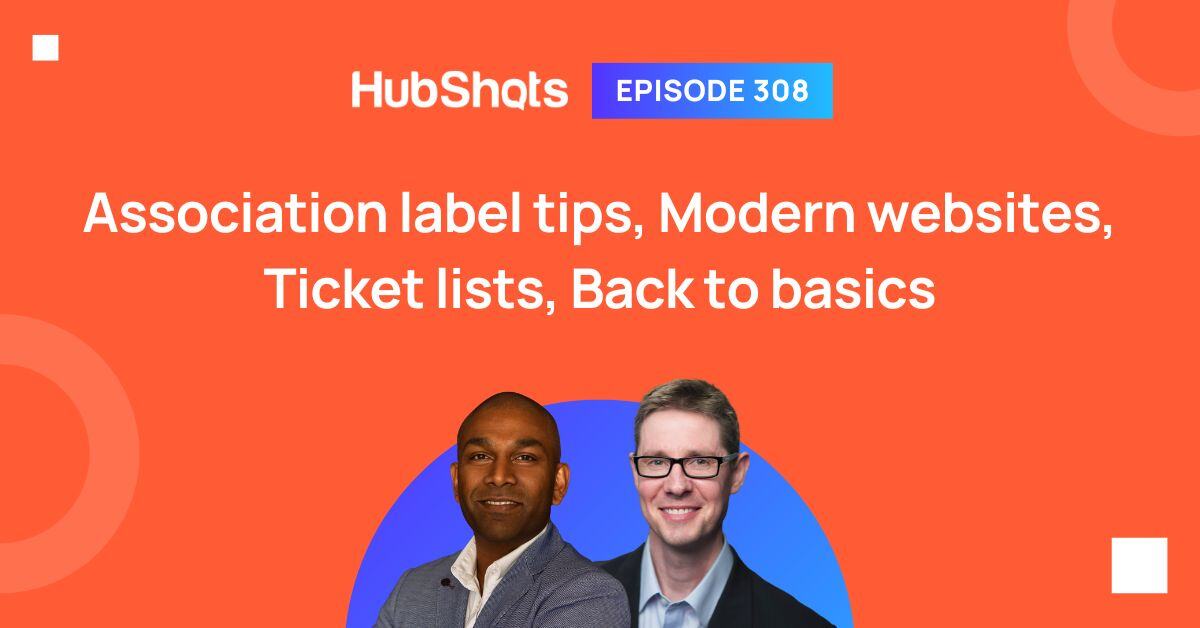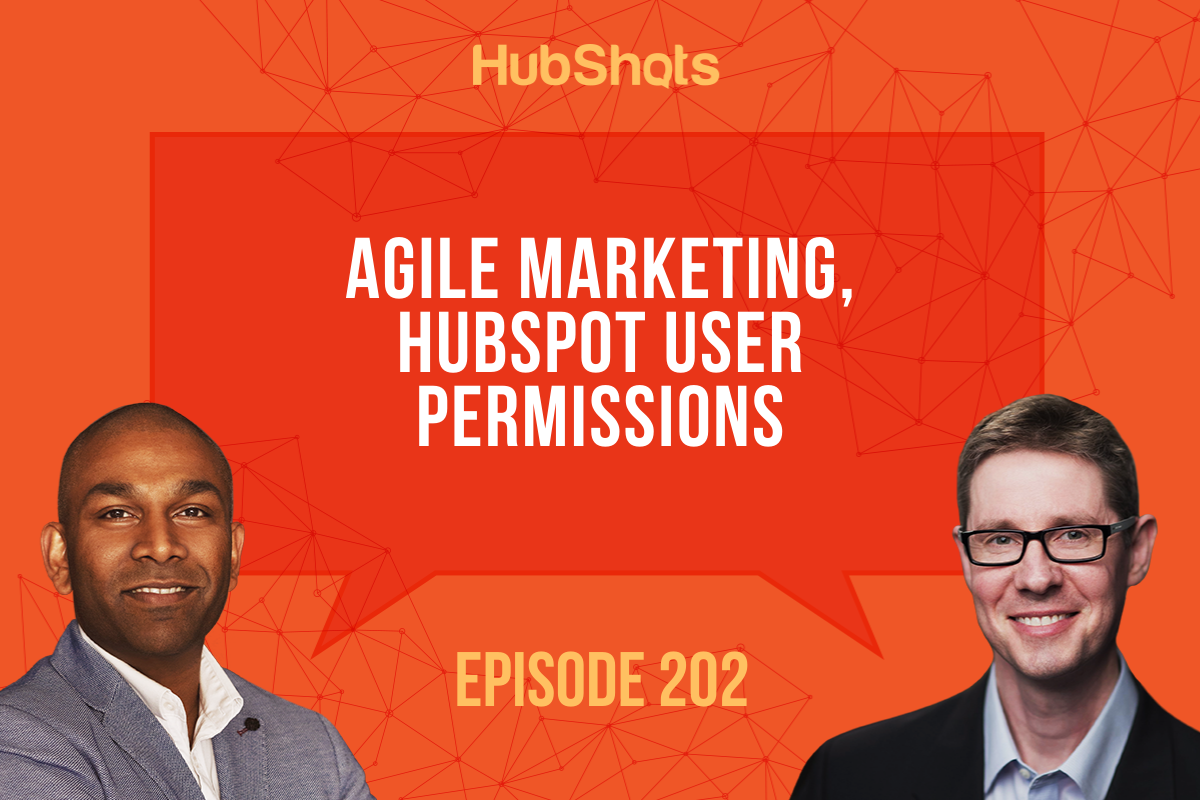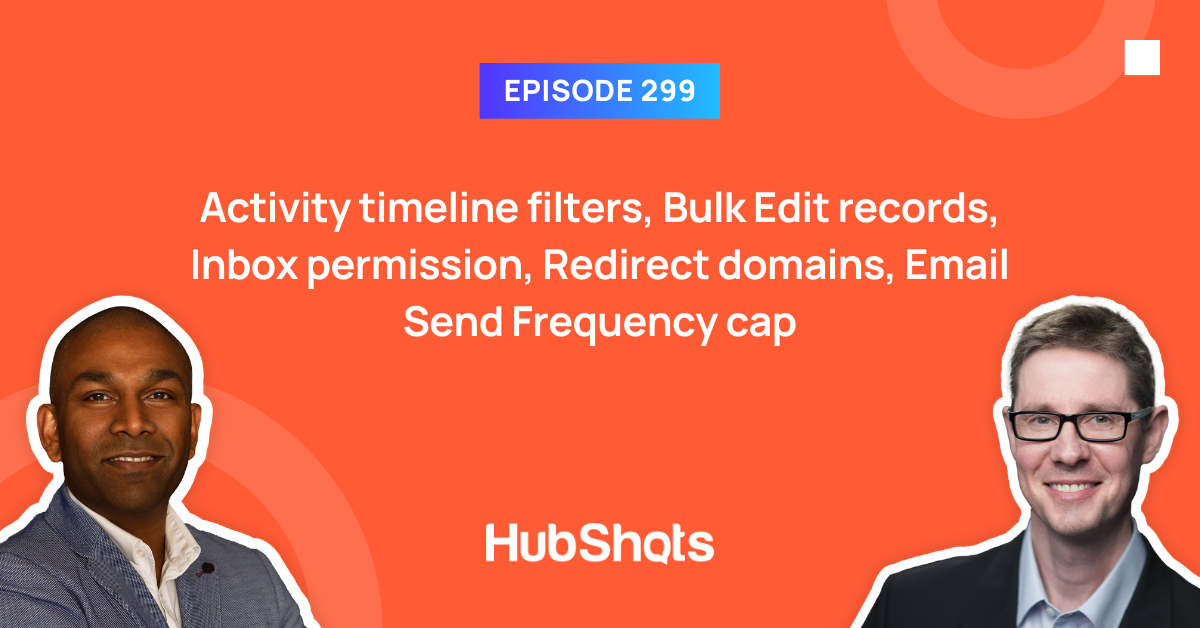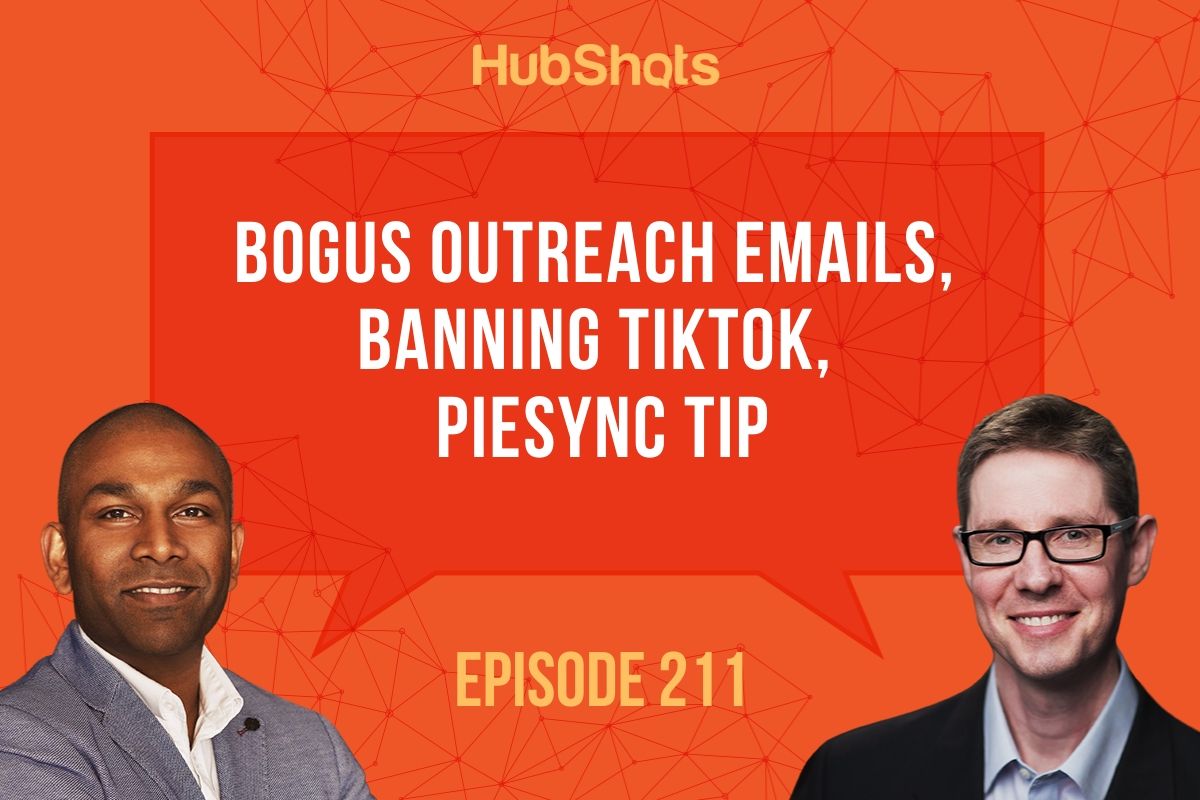Episode 202: Agile Marketing, HubSpot User Permissions
Welcome to HubShots Episode 202: Agile Marketing, HubSpot User Permissions This episode we chat about Agile marketing, HubSpot Email Analysis tools,...
If you're new to HubSpot, we guide you on where to start, how to do it right, and train you to make the most of the platform.
Review your HubSpot portal to uncover issues, spot growth opportunities, and ensure you're maximising its potential.
Unlock business growth with automation and attribution. Implement best practices and execute marketing campaigns.
HubSpot On-Demand
HubSpot Training
HubSpot Websites
HubSpot Campaigns
Virtual HubSpot Manager
8 min read
XEN Systems 29 July 2024 10:44:53 PM

This edition we dive into:
You can watch this episode on our YouTube episodes playlist.
Are you a subscriber on the HubShots YouTube channel?
Recorded: Tuesday 16 July 2024 | Published: Friday 19 July 2024
A lot of conversations we encounter with businesses are about solving problems.
Yet, so much of the chatter on LinkedIn is people talking about the latest ‘game changer’ features in HubSpot.
But that’s not what most users need. Instead, most still need to unlock the basics for their job. They just need the foundations in place first.
It’s hard when there are so many new features and shiny distractions though (eg just look at how much attention AI is commanding - and yet most companies haven’t even implemented any AI basics).
I discuss this more here and here - let me know your thoughts.
Recently Ian presented with HubSpot on the topic of AI. It was a popular event, more than 1000 people registered and 450 attended. You can watch a recording of the webinar here.
In the webinar Ian walks through:
More on this in our next episode where we’re going to dive into all the AI touchpoints (good and bad) in HubSpot.
Here’s a few quick items of interest we noticed:
How to use a custom email property on a contact for sending internal marketing emails.
(Shout out to Tom Haynes for teaching me this.)
As part of a Contact workflow, you can send an email to an email address that is on the contact’s record (ie you aren’t sending the email to the contact’s email address):

A typical example would be a form that captures multiple email addresses (eg a referral form). You can send separate emails to the contact and the referrer.
It’s the little things.
The permissions granularity in HubSpot is always improving (incremental improvements FTW!).
One of the useful permissions for sales teams is the ability to view other users’ Prospecting workspaces:

Ideal for a Sales Manager - they can then jump in and view what other sales reps are currently working on.
You can now set association labels in workflows.
That has been a long requested feature, ever since association labels were first introduced (years ago?).
One use case we’ve implemented this for is for setting an Employee status against a contact’s associated company - to label if they are a Former employee (versus Current employee) - see Shot 12 later for the full run through.
To set Association labels in Workflows you can use the new CRM actions:

The easiest way to add an association label is to use the ‘Update association labels’ action:

At its simplest you are just setting an association label between the current object (eg a contact record) and an associate object (eg a company record). You can also replace existing labels.
If there isn’t yet an association (eg the contact isn’t yet associated with a company), you can use the ‘Create association’ action to set the association and add the label:

This is actually a big deal.
Once you’ve put in place setting the association labels you can then use these labels to drive a bunch of other things eg other workflows, lists, reports and dashboards.
Quick tip - yes, you can reference Association labels in Lists, by first associating to the object and selecting a property on the object (eg we use a property that we know won’t be blank such as Create date), and then drilling into the association labels:

If you’d asked people 10 years ago what was the mark of a modern website, most probably would have ended up talking about how websites needed to work on mobile devices. At that time the conversation was around whether to have responsive websites, versus mobile-specific websites (ie remember all those m.companydomain.com sites).
These days we all take that for granted - of course a website needs to work on mobile.
So, what is the new indicator of a modern website?
I’m going to suggest that modern websites need to be built on a CRM. Actually, to clarify, modern ‘sales and marketing’ websites need to be built on a CRM. (Other sites eg a developer site or doco site or KB site, don’t necessarily need this).
So what does this mean?
A modern sales and marketing website needs to be able to track the journey of a visitor right through from initial visit to potentially being a long-time customer.
This is one of the reasons we’re so bullish on HubSpot’s CMS (ahem ‘content hub’) functionality. Everything to do with tracking the customer journey is built in - forms, analytics, page views, key marketing events, reports, campaign management, deals, revenue, and attribution reporting.
There are very few other platforms you can coordinate all this so easily.
We used WordPress for years (decades?) and combined it with Google Analytics (and other tools) and parts of HubSpot (eg tracking script and forms) and could only really get part of the way. Having now moved all our sites over to HubSpot entirely, we have much more clarity (and it’s easier).
That’s not to say the picture is complete - there’s still a bunch of holes (eg if a visitor blocks cookies then you miss a lot of key touches).
Worth thinking about for your company websites - I’ve been chatting with a number of companies lately who didn’t realise HubSpot was an option for their entire website (ie not just landing pages and blog posts). They’ve been excited to consider the possibilities.
Interested in a deep dive into HubSpot’s complete website feature set - check out our monster guide to building a website on HubSpot, using Content Hub (download here - no signup required)
This year HubSpot has been adding the ability to create lists on more objects ie not just Contacts and Companies, but also Deals, Tickets, Orders and Carts. This is welcome news.
Today we look at Ticket lists.
So, what’s the big deal about being to create a List of tickets (since you can easily create views already).
The answer comes back to something we’ve been highlighting on this show for years: Lists are the building blocks of HubSpot. You can view episode 280 for a refresher - even though we recorded that more than 2 years ago, it all still stands.
With Ticket Lists you can build common queries eg: all tickets closed in the last 30 days:

You can then use these lists in reports, workflows, dashboards, etc as well as Views.
Interestingly, the Ticket (and other object types) don’t yet appear in the quick filter options:

(I’m sure it’s coming)
In other news, HubSpot has been rolling out their new Customer Success Hub - worth checking out.
ChatSpot has been added to the top right menu within HubSpot portals:

(Also note that HubSpot Support help is now in the top menu ie no longer in the bottom right)
ChatSpot isn’t new - it was first announced more than a year ago back in March 2023. So how far has it come since then?
My experience with ChatSpot so far: pretty useless
Most of the prompts I use bring back total garbage from ChatSpot eg ‘what is the average number of sales activities on closed deals’ will bring back a table of all activities (ie nothing more that a long report)
ChatSpot provides a set of suggested prompts:

But these are mostly activities that can be achieved more quickly using the tools directly in the platform.
The only advantage I can see from ChatSpot is it being a type of help for new users. There are no insights available here.
And as is usual for all AI tools now we have the obligatory ‘may be inaccurate’ note down the bottom.
Similarly in Gemini in Google Workspace: they don’t even pretend it is anything but creative writing:

How did we get to this place? Why is it fine to roll out functionality that is unashamedly labelled as unreliable?
The AI hype cycle continues.
Which is best viewed as an opportunity (see Shot 11 later in the show).
“Great content. Great presenters. Great quality (audio+video). Learning a lot. Like it a lot!!”
- AreAlan has written up his experiences testing with Claude Sonnet.
Key point: understanding ‘artifacts’ and their uses.
Tons more Midjourney prompts and AI investigation here.
How the rise of AI content slop is creating an opportunity for people who create high-value content.
With every new, ‘easier’, scalable way to do anything, there’s sometimes an equal and opposite opportunity to focus on the old, ‘harder’, manual way to do something.
It’s why we have ‘artisanal’ everything these days. Artisanal clothes, artisanal coffee, artisanal soap, etc.
I wonder if there’s a growing opportunity for ‘artisanal’ content. I’m only half joking…
Or put another way: quality content
The sheer quantity of AI-generated slop being pumped out is creating a massive ‘noise’ layer, that perhaps makes it easier to stand out with quality ‘signal’.
This can be considered across all parts of your content generation - focus on quality (not quantity) - from writing, to images, to video production.
It also perhaps creates opportunities in how we engage - expect the one-to-one messaging channels to gain more traction. But importantly, it will be in the prospect initiated channels (eg WhatsApp), not the outbound channels (eg LinkedIn DMs).
For more on this, Noah Smith’s essay is a good conversation starter. Interesting times ahead. (Artisanal content)
“Judge a person by the quality of their questions, rather than their answers.”
“Life is a question - how we live it is our answer.”
This scenario comes up a fair bit - you've likely thought about it too. How to track when a contact changes company.
In the following video, I walk through how we do it:
It's not perfect - we would love to hear tips from others about how you manage this in your business (and for your clients as well). You can comment on my LinkedIn post here.
BTW that video is on our brand new HubShots Shorts channel - it’s our second YouTube channel, just for the shorter videos.
Download a copy of the HubShots Framework A3 PDF poster (recently updated with colour coding and more).
Connect with HubShots here:
Connect with Ian Jacob on LinkedIn and Craig Bailey on Threads
HubShots, the podcast for marketing managers and sales professionals who use HubSpot, hosted by Ian Jacob from Search & Be Found and Craig Bailey from XEN Systems, XEN Create and XEN Solar.
HubShots is produced by Christopher Mottram from Podcastily.
Please share this with colleagues - it helps us improve and reach more marketers.

Welcome to HubShots Episode 202: Agile Marketing, HubSpot User Permissions This episode we chat about Agile marketing, HubSpot Email Analysis tools,...

Welcome to HubShots Episode 299: Activity timeline filters, Bulk Edit records, Inbox permission, Redirect domains, Email Send Frequency cap

Welcome to HubShots Episode 211: Bogus outreach emails, banning TikTok, PieSync tip This episode we discuss bogus outreach emails, banning TikTok and...